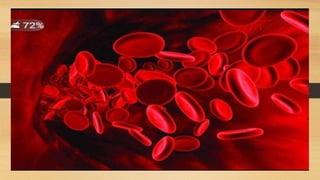Fundamental Of Biology to prserve the way of blood compostptx
- 1. Composition Of Blood Subject: Fundamental Of Biology Name :Ashar Abbas
- 3. Introduction • Welcome and introduce the topic: Blood Composition: A Comprehensive Overview. • Briefly explain the importance of understanding the composition of blood. • Highlight the role of blood in maintaining overall health and bodily functions.
- 4. Functions Of Blood • The primary functions of blood: • Transportation: Carries oxygen, nutrients, hormones, and waste products throughout the body. • Regulation: Maintains body temperature, pH balance, and electrolyte levels. • Protection: Helps in clotting, immune response, and preventing infections.
- 5. Components Of Blood • Blood consists of two main components: plasma and formed elements. • Plasma: The liquid portion of blood that makes up about 55% of total blood volume. • Composed of water, proteins, hormones, electrolytes, and waste products. • Formed Elements: The cellular components of blood that make up about 45% of total blood volume. • Red blood cells (erythrocytes), white blood cells (leukocytes), and platelets (thrombocytes).
- 6. Plasma • Plasma composition: • Water: Makes up the majority of plasma volume. • Proteins: Albumin, globulins, and fibrinogen play various roles in blood function. • Hormones: Transported by plasma to target tissues. • Electrolytes: Help maintain osmotic pressure and pH balance. • Waste products: Urea, creatinine, and bilirubin are carried by plasma for elimination.
- 7. Red Blood Cells • Red Blood Cells (Erythrocytes) • Characteristics and functions of red blood cells: • Structure: Biconcave disc-shaped cells without a nucleus. • Hemoglobin: Protein that carries oxygen and carbon dioxide. • Function: Transport oxygen from the lungs to body tissues and remove carbon dioxide.
- 9. White Blood Cells • White Blood Cells (Leukocytes)- Explain the types and functions of white blood cells: • Granulocytes: Neutrophils, eosinophils, and basophils. Involved in immune response and defense against infections. • Agranulocytes: Lymphocytes and monocytes. Play a role in immune response and phagocytosis.
- 10. Platelets • Platelets (Thrombocytes) • Characteristics and functions of platelets: Structure: Small cell fragments without a nucleus. Function: Essential for blood clotting (hemostasis) to prevent excessive bleeding.
- 11. Hematopoiesis • Hematopoiesis • Process of hematopoiesis: • Occurs in the bone marrow. • Stem cells differentiate into various blood cell types. • Controlled by growth factors and hormones.
- 12. Blood Groups &Rh Factor • Blood Groups and Rh Factor • Introduce the concept of blood groups and the Rh factor: • ABO blood group system: • A, B, AB, and O blood types. • Rh factor: Refers to the presence or absence of the Rh antigen on red blood cells.
- 13. Blood Disorders • Blood Disorders • Provide an overview of common blood disorders: • Anemia: Decreased red blood cell count or hemoglobin levels. • Leukemia: Cancer of the blood-forming cells in the bone marrow. • Thrombocytopenia: Low platelet count, leading to increased bleeding risk.
- 14. Conclusion • Summarize the key points discussed in the presentation. • Emphasize the vital role blood composition plays in maintaining overall health. • Encourage further exploration of the topic and address.
- 15. Thank You For Listening Any Questions ❓














